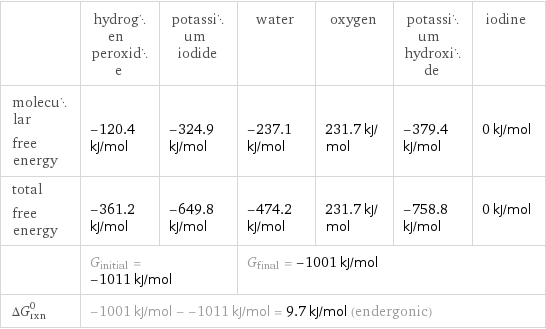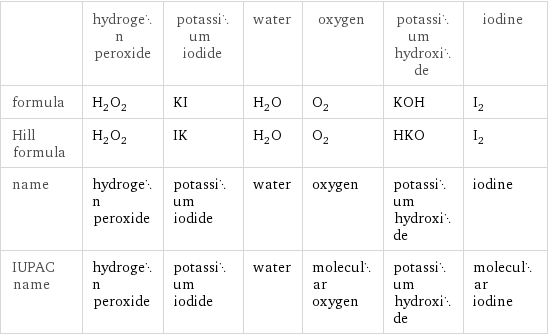Input interpretation

H_2O_2 (hydrogen peroxide) + KI (potassium iodide) ⟶ H_2O (water) + O_2 (oxygen) + KOH (potassium hydroxide) + I_2 (iodine)
Balanced equation

Balance the chemical equation algebraically: H_2O_2 + KI ⟶ H_2O + O_2 + KOH + I_2 Add stoichiometric coefficients, c_i, to the reactants and products: c_1 H_2O_2 + c_2 KI ⟶ c_3 H_2O + c_4 O_2 + c_5 KOH + c_6 I_2 Set the number of atoms in the reactants equal to the number of atoms in the products for H, O, I and K: H: | 2 c_1 = 2 c_3 + c_5 O: | 2 c_1 = c_3 + 2 c_4 + c_5 I: | c_2 = 2 c_6 K: | c_2 = c_5 Since the coefficients are relative quantities and underdetermined, choose a coefficient to set arbitrarily. To keep the coefficients small, the arbitrary value is ordinarily one. For instance, set c_4 = 1 and solve the system of equations for the remaining coefficients: c_2 = 2 c_1 - 4 c_3 = 2 c_4 = 1 c_5 = 2 c_1 - 4 c_6 = c_1 - 2 The resulting system of equations is still underdetermined, so an additional coefficient must be set arbitrarily. Set c_1 = 3 and solve for the remaining coefficients: c_1 = 3 c_2 = 2 c_3 = 2 c_4 = 1 c_5 = 2 c_6 = 1 Substitute the coefficients into the chemical reaction to obtain the balanced equation: Answer: | | 3 H_2O_2 + 2 KI ⟶ 2 H_2O + O_2 + 2 KOH + I_2
Structures

+ ⟶ + + +
Names

hydrogen peroxide + potassium iodide ⟶ water + oxygen + potassium hydroxide + iodine
Reaction thermodynamics
Gibbs free energy

| hydrogen peroxide | potassium iodide | water | oxygen | potassium hydroxide | iodine molecular free energy | -120.4 kJ/mol | -324.9 kJ/mol | -237.1 kJ/mol | 231.7 kJ/mol | -379.4 kJ/mol | 0 kJ/mol total free energy | -361.2 kJ/mol | -649.8 kJ/mol | -474.2 kJ/mol | 231.7 kJ/mol | -758.8 kJ/mol | 0 kJ/mol | G_initial = -1011 kJ/mol | | G_final = -1001 kJ/mol | | | ΔG_rxn^0 | -1001 kJ/mol - -1011 kJ/mol = 9.7 kJ/mol (endergonic) | | | | |
Equilibrium constant
![Construct the equilibrium constant, K, expression for: H_2O_2 + KI ⟶ H_2O + O_2 + KOH + I_2 Plan: • Balance the chemical equation. • Determine the stoichiometric numbers. • Assemble the activity expression for each chemical species. • Use the activity expressions to build the equilibrium constant expression. Write the balanced chemical equation: 3 H_2O_2 + 2 KI ⟶ 2 H_2O + O_2 + 2 KOH + I_2 Assign stoichiometric numbers, ν_i, using the stoichiometric coefficients, c_i, from the balanced chemical equation in the following manner: ν_i = -c_i for reactants and ν_i = c_i for products: chemical species | c_i | ν_i H_2O_2 | 3 | -3 KI | 2 | -2 H_2O | 2 | 2 O_2 | 1 | 1 KOH | 2 | 2 I_2 | 1 | 1 Assemble the activity expressions accounting for the state of matter and ν_i: chemical species | c_i | ν_i | activity expression H_2O_2 | 3 | -3 | ([H2O2])^(-3) KI | 2 | -2 | ([KI])^(-2) H_2O | 2 | 2 | ([H2O])^2 O_2 | 1 | 1 | [O2] KOH | 2 | 2 | ([KOH])^2 I_2 | 1 | 1 | [I2] The equilibrium constant symbol in the concentration basis is: K_c Mulitply the activity expressions to arrive at the K_c expression: Answer: | | K_c = ([H2O2])^(-3) ([KI])^(-2) ([H2O])^2 [O2] ([KOH])^2 [I2] = (([H2O])^2 [O2] ([KOH])^2 [I2])/(([H2O2])^3 ([KI])^2)](../image_source/9b32d77a436b90a650f0e87b9d503443.png)
Construct the equilibrium constant, K, expression for: H_2O_2 + KI ⟶ H_2O + O_2 + KOH + I_2 Plan: • Balance the chemical equation. • Determine the stoichiometric numbers. • Assemble the activity expression for each chemical species. • Use the activity expressions to build the equilibrium constant expression. Write the balanced chemical equation: 3 H_2O_2 + 2 KI ⟶ 2 H_2O + O_2 + 2 KOH + I_2 Assign stoichiometric numbers, ν_i, using the stoichiometric coefficients, c_i, from the balanced chemical equation in the following manner: ν_i = -c_i for reactants and ν_i = c_i for products: chemical species | c_i | ν_i H_2O_2 | 3 | -3 KI | 2 | -2 H_2O | 2 | 2 O_2 | 1 | 1 KOH | 2 | 2 I_2 | 1 | 1 Assemble the activity expressions accounting for the state of matter and ν_i: chemical species | c_i | ν_i | activity expression H_2O_2 | 3 | -3 | ([H2O2])^(-3) KI | 2 | -2 | ([KI])^(-2) H_2O | 2 | 2 | ([H2O])^2 O_2 | 1 | 1 | [O2] KOH | 2 | 2 | ([KOH])^2 I_2 | 1 | 1 | [I2] The equilibrium constant symbol in the concentration basis is: K_c Mulitply the activity expressions to arrive at the K_c expression: Answer: | | K_c = ([H2O2])^(-3) ([KI])^(-2) ([H2O])^2 [O2] ([KOH])^2 [I2] = (([H2O])^2 [O2] ([KOH])^2 [I2])/(([H2O2])^3 ([KI])^2)
Rate of reaction
![Construct the rate of reaction expression for: H_2O_2 + KI ⟶ H_2O + O_2 + KOH + I_2 Plan: • Balance the chemical equation. • Determine the stoichiometric numbers. • Assemble the rate term for each chemical species. • Write the rate of reaction expression. Write the balanced chemical equation: 3 H_2O_2 + 2 KI ⟶ 2 H_2O + O_2 + 2 KOH + I_2 Assign stoichiometric numbers, ν_i, using the stoichiometric coefficients, c_i, from the balanced chemical equation in the following manner: ν_i = -c_i for reactants and ν_i = c_i for products: chemical species | c_i | ν_i H_2O_2 | 3 | -3 KI | 2 | -2 H_2O | 2 | 2 O_2 | 1 | 1 KOH | 2 | 2 I_2 | 1 | 1 The rate term for each chemical species, B_i, is 1/ν_i(Δ[B_i])/(Δt) where [B_i] is the amount concentration and t is time: chemical species | c_i | ν_i | rate term H_2O_2 | 3 | -3 | -1/3 (Δ[H2O2])/(Δt) KI | 2 | -2 | -1/2 (Δ[KI])/(Δt) H_2O | 2 | 2 | 1/2 (Δ[H2O])/(Δt) O_2 | 1 | 1 | (Δ[O2])/(Δt) KOH | 2 | 2 | 1/2 (Δ[KOH])/(Δt) I_2 | 1 | 1 | (Δ[I2])/(Δt) (for infinitesimal rate of change, replace Δ with d) Set the rate terms equal to each other to arrive at the rate expression: Answer: | | rate = -1/3 (Δ[H2O2])/(Δt) = -1/2 (Δ[KI])/(Δt) = 1/2 (Δ[H2O])/(Δt) = (Δ[O2])/(Δt) = 1/2 (Δ[KOH])/(Δt) = (Δ[I2])/(Δt) (assuming constant volume and no accumulation of intermediates or side products)](../image_source/21a551f33b6c49f632ad9d64adf30da5.png)
Construct the rate of reaction expression for: H_2O_2 + KI ⟶ H_2O + O_2 + KOH + I_2 Plan: • Balance the chemical equation. • Determine the stoichiometric numbers. • Assemble the rate term for each chemical species. • Write the rate of reaction expression. Write the balanced chemical equation: 3 H_2O_2 + 2 KI ⟶ 2 H_2O + O_2 + 2 KOH + I_2 Assign stoichiometric numbers, ν_i, using the stoichiometric coefficients, c_i, from the balanced chemical equation in the following manner: ν_i = -c_i for reactants and ν_i = c_i for products: chemical species | c_i | ν_i H_2O_2 | 3 | -3 KI | 2 | -2 H_2O | 2 | 2 O_2 | 1 | 1 KOH | 2 | 2 I_2 | 1 | 1 The rate term for each chemical species, B_i, is 1/ν_i(Δ[B_i])/(Δt) where [B_i] is the amount concentration and t is time: chemical species | c_i | ν_i | rate term H_2O_2 | 3 | -3 | -1/3 (Δ[H2O2])/(Δt) KI | 2 | -2 | -1/2 (Δ[KI])/(Δt) H_2O | 2 | 2 | 1/2 (Δ[H2O])/(Δt) O_2 | 1 | 1 | (Δ[O2])/(Δt) KOH | 2 | 2 | 1/2 (Δ[KOH])/(Δt) I_2 | 1 | 1 | (Δ[I2])/(Δt) (for infinitesimal rate of change, replace Δ with d) Set the rate terms equal to each other to arrive at the rate expression: Answer: | | rate = -1/3 (Δ[H2O2])/(Δt) = -1/2 (Δ[KI])/(Δt) = 1/2 (Δ[H2O])/(Δt) = (Δ[O2])/(Δt) = 1/2 (Δ[KOH])/(Δt) = (Δ[I2])/(Δt) (assuming constant volume and no accumulation of intermediates or side products)
Chemical names and formulas

| hydrogen peroxide | potassium iodide | water | oxygen | potassium hydroxide | iodine formula | H_2O_2 | KI | H_2O | O_2 | KOH | I_2 Hill formula | H_2O_2 | IK | H_2O | O_2 | HKO | I_2 name | hydrogen peroxide | potassium iodide | water | oxygen | potassium hydroxide | iodine IUPAC name | hydrogen peroxide | potassium iodide | water | molecular oxygen | potassium hydroxide | molecular iodine